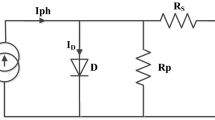Abstract
Currently, the use of Field Programmable Gate Array (FPGA) devices as control platforms is common in areas where real-time control is important, as renewable energy system. Grid-connected photovoltaic systems require control strategies to optimize the performance of the complete system. This article presents the implementation of a control strategy on a FPGA platform working with a single-phase grid-connected photovoltaic system developed in MATLAB/Simulink environment. The control strategy of the system consists of a variable-step MPPT algorithm with a predictive current control to operate a boost converter on the first stage. In the second stage, a simplified active and reactive power control ensures that the maximum power is transferred to the grid trough a cascaded H-bridge multilevel inverter. A single-phase PLL based on the PQ theory is used to track the frequency of the grid. The results obtained in the simulation allow to validate the proposed strategy.

















Similar content being viewed by others
References
Malinowski M, Leon J I, Abu-Rub H (2017) Solar photovoltaic and thermal energy systems: current technology and future trends. Proc IEEE 99:1–15
Hassaine L (2016) Power converters and control of grid-connected photovoltaic systems. Springer International Publishing, Cham
Zeng Zheng, Yang Huan, Zhao Rongxiang, Cheng Chong (2013) Topologies and control strategies of multi-functional grid-connected inverters for power quality enhancement: a comprehensive review. Renew Sustain Energy Rev 24:223–270
Bendib Boualem, Belmili Hocine, Krim Fateh (2015) A survey of the most used MPPT methods: conventional and advanced algorithms applied for photovoltaic systems. Renew Sustain Energy Rev 45:637–648
Rezk Hegazy, Eltamaly Ali M (2015) A comprehensive comparison of different MPPT techniques for photovoltaic systems. Solar Energy 112:1–11
Tajuddin MFN, Arif MS, Ayob SM, Salam Z (2015) Perturbative methods for maximum power point tracking (mppt) of photovoltaic (pv) systems: a review. Int J Energy Res 39(9):1153–1178 ER-14-5003.R1
Sajadian S, Ahmadi R (2016) Model predictive-based maximum power point tracking for grid-tied photovoltaic applications using a z-source inverter. IEEE Trans Power Electron 31(11):7611–7620
Metry M, Shadmand MB, Balog RS, Abu-Rub H (2017) Mppt of photovoltaic systems using sensorless current-based model predictive control. IEEE Trans Ind Appl 53(2):1157–1167
Metry M, Shadmand MB, Balog RS, Rub HA (2015) Sensitivity analysis to model parameter errors of mppt by model predictive control for photovoltaic applications. In: 2015 First Workshop on Smart Grid and Renewable Energy (SGRE), pp 1–6
Kakosimos PE, Kladas AG, Manias SN (2013) Fast photovoltaic-system voltage- or current-oriented mppt employing a predictive digital current-controlled converter. IEEE Trans Ind Electron 60(12):5673–5685
Shadmand MB, Li X, Balog RS, Rub HA (2015) Model predictive control of grid-tied photovoltaic systems: maximum power point tracking and decoupled power control. In: 2015 First Workshop on Smart Grid and Renewable Energy (SGRE), pp 1–6
Abushaiba AA, Eshtaiwi SMM, Ahmadi R (2016) A new model predictive based maximum power point tracking method for photovoltaic applications. In: 2016 IEEE International Conference on Electro Information Technology (EIT), pp 0571–0575
Morales-Caporal M, Rangel-Magdaleno J, Morales-Caporal R (2016) Digital simulation of a predictive current control for photovoltaic system based on the mppt strategy. In: 2016 13th International Conference on Power Electronics (CIEP), pp 295–299
Kouro S, Cortes P, Vargas R, Ammann U, Rodriguez J (2009) Model predictive control—a simple and powerful method to control power converters. IEEE Trans Ind Electron 56(6):1826–1838
Karamanakos P, Geyer T, Manias S (2013) Direct model predictive current control strategy of dc–dc boost converters. IEEE J Emerg Sel Top Power Electron 1(4):337–346
Bin Wu (2005) Cascaded H-bridge multilevel inverters. John Wiley, New York
Rodriguez J, Lai Jih-Sheng, Peng Fang Zheng (2002) Multilevel inverters: a survey of topologies, controls and applications. IEEE Trans Ind Electron 49(4):724–738
Xiao B, Shen K, Mei J, Filho F, Tolbert LM (2012) Control of cascaded H-bridge multilevel inverter with individual mppt for grid-connected photovoltaic generators. In: 2012 IEEE Energy Conversion Congress and Exposition (ECCE), pp 3715–3721
Shehadeh SH, Aly HH, El-Hawary ME (2015) Photovoltaic multi-level inverters technology. In: 2015 IEEE 28th Canadian Conference on Electrical and Computer Engineering (CCECE), pp 648–655
Ramirez FA, Arjona MA (2012) Development of a grid-connected wind generation system with a modified pll structure. IEEE Trans Sustain Energy 3(3):474–481
Oliveira da Silva SA, Novochadlo R, Modesto RA (2008) Single-phase pll structure using modified p-q theory for utility connected systems. In: 2008 IEEE Power Electronics Specialists Conference, pp 4706–4711
Rodriguez-Andina JJ, Moure MJ, Valdes MD (2007) Features, design tools, and application domains of fpgas. IEEE Trans Ind Electron 54(4):1810–1823
Vallone J, Geyer T, Rohr ER (2016) Fpga implementation of model predictive direct current control. In: 2016 IEEE Energy Conversion Congress and Exposition (ECCE), pp 1–8
Hassaine L, OLias E, Quintero J, Salas V (2014) Overview of power inverter topologies and control structures for grid connected photovoltaic systems. Renew Sustain Energy Rev 30:796–807
Hassaine L, Olias E, Quintero J, Haddadi M (2009) Digital power factor control and reactive power regulation for grid-connected photovoltaic inverter. Renew Energy 34(1):315–321
Author information
Authors and Affiliations
Corresponding author
Rights and permissions
About this article
Cite this article
Morales-Caporal, M., Rangel-Magdaleno, J., Peregrina-Barreto, H. et al. FPGA-in-the-loop simulation of a grid-connected photovoltaic system by using a predictive control. Electr Eng 100, 1327–1337 (2018). https://doi.org/10.1007/s00202-017-0596-1
Received:
Accepted:
Published:
Issue Date:
DOI: https://doi.org/10.1007/s00202-017-0596-1




